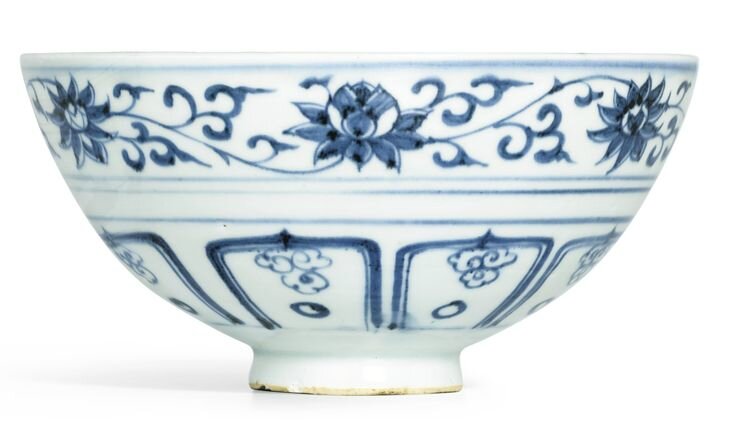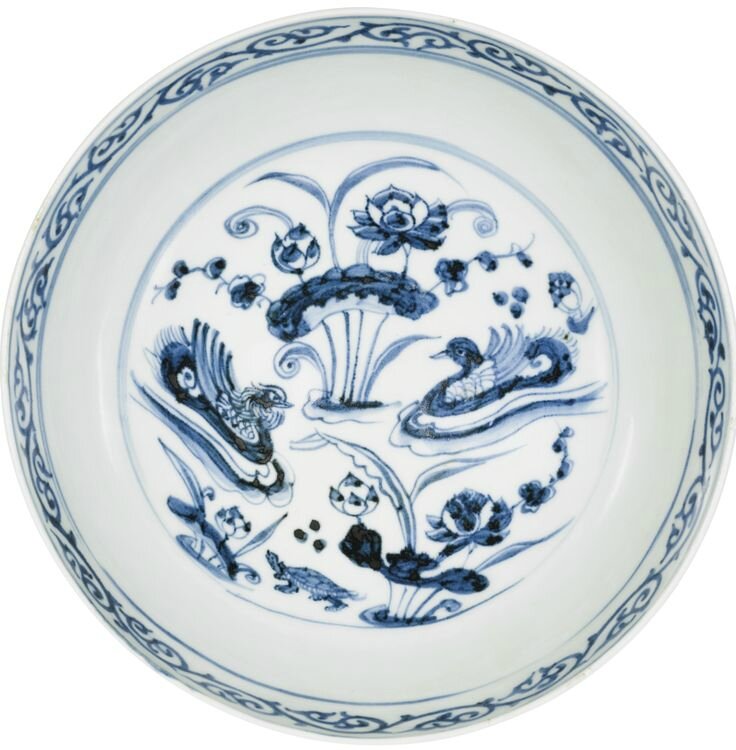A blue and white 'Mandarin ducks' bowl, Yuan dynasty
Lot 109. A blue and white 'Mandarin ducks' bowl, Yuan dynasty; 18cm., 7in. Estimate 80,000 — 120,000 GBP. Lot sold 112,500 GBP. Photo: Sotheby's.
the rounded sides rising from a slightly spreading foot, the interior painted with two mandarin ducks in a lotus pond above a tortoise within a circular panel, below a wide band of classic scroll at the rim, the exterior painted with a band of scrolling lotus above a wide band of lappets at the foot.
Note: This charming bowl is remarkable for its painterly design of mandarin ducks swimming in a lotus pond, but is particularly noteworthy on account of a playful detail extremely rarely found on pieces of this design: Besides the ducks, the lotus pond here also houses another water creature, a turtle, symbol of longevity and one of the Four Divine Creatures of the Chinese constellation. The turtle was considered so auspicious in China that the character designating it, gui, was often chosen for personal names. In the Tang dynasty (618-907), for example, it appears in the name of the great poet Lu Guimeng ( ? -881), and that of the outstanding musician favoured by the Emperor, Li Guinian (Guinian meaning ‘live as long as the turtle’).
This bowl is also unusual for its small size and conical form, and bowls of this design are more commonly modelled with a lipped rim; see for example a larger bowl in the Museum of Oriental Ceramics, Osaka, included in the exhibition Splendors in Smalt. Art of Yuan Blue-and-White Porcelain, Shanghai Museum, Shanghai, 2012, cat. no. 22, together with one excavated in Wuwei, Gansu province, and now in the Wuwei Museum, cat. no. 45. Compare also a stembowl, similarly shaped with straight sides and the interior painted with mandarin ducks, sold in our Hong Kong rooms, 20th May 1981, lot 684.
Compare also a bowl recovered from the site of the Kotla Firuzshah palace in Delhi, which was destroyed in AD 1398, illustrated in Ellen Smart, ‘Fourteenth Century Chinese Porcelain from a Tughlaq Palace in Delhi’, Transactions of the Oriental Ceramic Society, vol. 51, 1975-7, pl. 86c; and another unearthed at Puerto Galera, Philippines, published in J.M. Addis, Early Blue and White Excavated in the Philippines, Manila, 1968, pl. 24.
Sotheby's. Important Chinese Art, Londres, 13 mai 2015, 11:00 AM

/https%3A%2F%2Fprofilepics.canalblog.com%2Fprofilepics%2F1%2F0%2F100183.jpg)
/https%3A%2F%2Fstorage.canalblog.com%2F03%2F02%2F119589%2F96711876_o.jpg)
/https%3A%2F%2Fstorage.canalblog.com%2F11%2F31%2F119589%2F94773502_o.jpg)
/https%3A%2F%2Fstorage.canalblog.com%2F20%2F83%2F119589%2F94772815_o.jpg)
/https%3A%2F%2Fstorage.canalblog.com%2F26%2F72%2F119589%2F75604929_o.jpg)
/https%3A%2F%2Fstorage.canalblog.com%2F59%2F60%2F119589%2F26458628_o.jpg)




/image%2F1371349%2F20240416%2Fob_2a8420_437713933-1652609748842371-16764302136.jpg)
/image%2F1371349%2F20240414%2Fob_83ee65_2024-nyr-22642-0954-000-a-blue-and-whi.jpg)
/image%2F1371349%2F20240414%2Fob_15808c_2024-nyr-22642-0953-000-a-blue-and-whi.jpg)
/image%2F1371349%2F20240414%2Fob_e54295_2024-nyr-22642-0952-000-a-rare-blue-an.jpg)